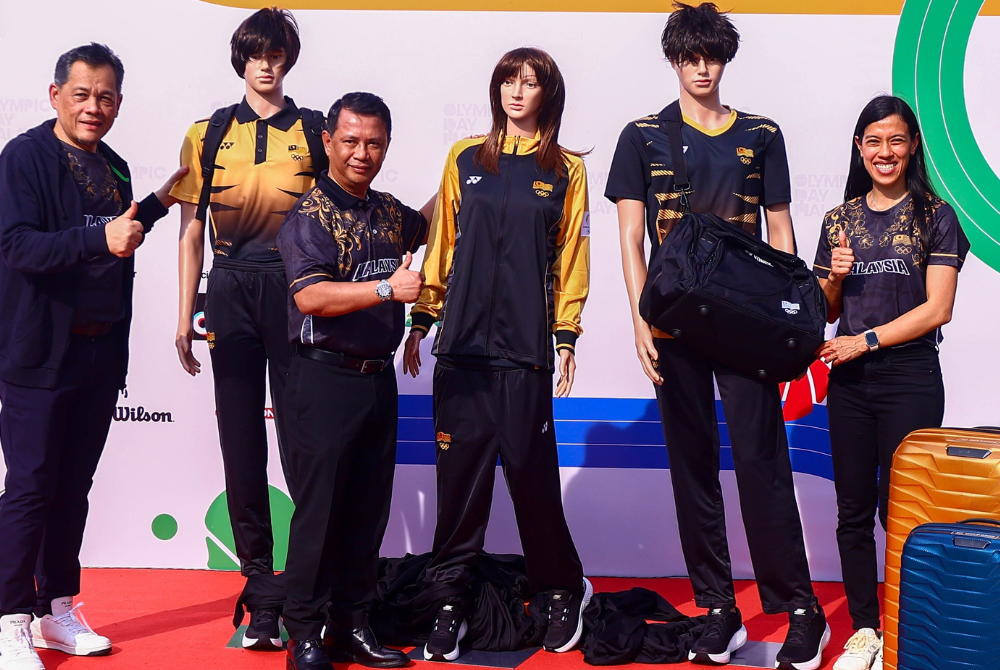Malaysia's Olympic fashion faux pas: Where did it go wrong?
Was it a case of too many cooks in the kitchen?

FIRST impressions matter, especially on the grand stage of the Olympics where the eyes of the world will be on the athletes, and their clothes.
Fashion is undeniably a big part of the sporting event, but it’s expected to play a bigger role in the Paris 2024 Olympic Games than ever before.
Surely, Malaysians had hopes to give our national athletes a fashionable sendoff to the fashion capital of the world, but unfortunately those plans have hit a snag with the unveiling of the less-than-appealing official attire.
The designs and the use of mannequins instead of actual athletes during its launch failed to draw unanimous applause. There was just too many things wrong there, first off - the wigs, absolutely unproportionate and at the very least they could've combed the hair (like seriously); second, the pants pretty much paid homeage to Justin Bieber's teenage saggy jeans era (they were about to fall off any second); and lastly, were the mannequins picked up from a recycling warehouse? (I reserve further comments but ikykwim)
Some of the comments left on social media by riled up Malaysians was that it were “cheap-looking” “ugly” and “did a school kid design this?” (my favourite).
The gold theme attire was aimed to reflect Malaysia’s pursuit for gold, but others believed it should have included elements and hues of the Jalur Gemilang.
The absence of the tiger stripes, which has become synonymous with the national sports contingent also drew flak.
I have to agree with one of the comments, it seemed more like a rushed school project put together by a group of students at the eleventh hour, with a “lets-make-do-with-what-we-have” approach.
I mean, it’s just the Summer Olympics, no pressure. It only averages about three billion viewership worldwide, a different story for the Winter Games, where the past four events averaged around 1.9 billion viewers worldwide.
And to be sending off our athletes in that less than impressive attire to the world’s fashion capital - what gives, right?
Plus, Chef de Mission (CDM) Datuk Hamidin Mohd Amin said the design holds no significance if the athletes fail to achieve the nation’s first gold medal in Paris.

After the designs were revealed, it became political and the aftermath was (and still is) messy. From endless memes endless online criticism, Malaysians even resorted to take it upon themselves to offer better designs with the help of AI.
But the wrath of the Malaysians was undeniable, and it was this collective outcry that ultimately prompted the Olympic Council of Malaysia to reconsider their fashion faux pas.
The Olympic Council of Malaysia (OCM) is reportedly in the works of designing an exclusive new outfit for the event, in partnership with Yonex.
This new line-up will dress about 25 athletes, but other team members like support staff, coaches and officials will stick to the controversial attire.

Youth and Sports Minister Hannah Yeoh said the controversial attire was not meant for the parade uniform, and that there is another set for athletes. But if the attire wasn’t meant for the parade, what was it meant for?
When Yeoh earlier clarified on X (formerly Twitter) that the Youth and Sports Ministry (KBS) and the National Sports Council (MSN) has no control of the design, it painted a perception that she acknowledges the fashion mishap but prefers not to shoulder the responsibility and point fingers at others instead.
Adding more icing to the cake, former Youth and Sports Minister Khairy Jamaluddin took a jab at Yeoh's distancing from the outfit on his Keluar Sekajap podcast when he openly stated that he was actively involved in the design process and approval of the nation's attire at the 29th SEA Games Kuala Lumpur 2017.
Yeoh responded to his statement, saying that the designs for the official gear comes under the jurisdiction of the OCM. She also took a swipe at Khairy, "When it was his era, it was his style of approaching things. Every leader has different leadership ways, for me, I respect our stakeholders" alluding that he crossed boundaries, while she maintained the standard procedures.
But this is a national send off to a global event representing the country. Shouldn't there have been some input from the ministry? How did it pass through the multiple layers of approval? Did anyone in the room have any fashion expertise at all or at least understand what is decent and pleasing to the eyes?
In other countries, some of the biggest fashion names design the official gear for their respective teams.

Ralph Lauren is for Team USA, Beruti is for Team France, The North Face for Team USA, Team Japan, Team South Korea and Team Austria, for example.
Whether it’s meant for the parade or not, these uniforms should do more than just look good; they tell a story, they're symbols of national pride.
This sartorial storytelling is crucial, as it allows countries to showcase their unique identities on the global stage. Like it or not, fashion plays a big role in the Olympics and we can’t ignore that.
Malaysia has an impressive roster of fashion designers who have earned international acclaim respectively. Why didn’t we tap into our homegrown talent?
Names like Rizman Ruzaini, Bernard Chandra, Melinda Looi all understand the delicate balance of tradition and modernity.
This highlights a broader issue of underutilising local talent. Malaysia has the creativity, and vision needed to make a statement. It’s about time we let our homegrown designers shine, representing our nation on the global stage.
Was it a case of too many cooks in the kitchen, each adding their own splash of madness to the melting pot or did the designers simply lose sight of the fact that Olympic attire should reflect national pride and athletic elegance, not serve as an eyesore?
One thing's for sure, Malaysia's Olympic attire for Paris 2024 has already made its mark in the annals of Olympic fashion history—for better or worse.
Here's hoping the next iteration will be a triumph of design that our athletes can wear with pride because they deserve it. Malaysia boleh.












